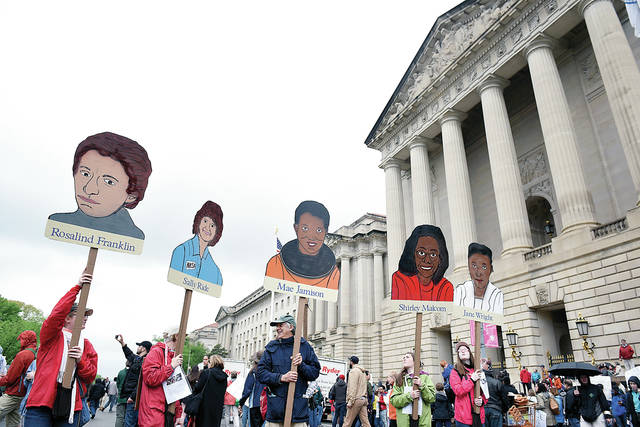WASHINGTON — The world saw brain power take a different form Saturday. ADVERTISING WASHINGTON — The world saw brain power take a different form Saturday. From the Washington Monument to Germany’s Brandenburg Gate and even to Greenland, scientists, students and
WASHINGTON — The world saw brain power take a different form Saturday.
From the Washington Monument to Germany’s Brandenburg Gate and even to Greenland, scientists, students and research advocates rallied on an often soggy Earth Day, conveying a global message about scientific freedom without political interference, the need for adequate spending for future breakthroughs and just the general value of scientific pursuits.
They came in numbers that were mammoth if not quite astronomical.
“We didn’t choose to be in this battle, but it has come to the point where we have to fight because the stakes are too great,” said Pennsylvania State University climate scientist Michael Mann, who regularly clashes with politicians.
President Donald Trump, in an Earth Day statement hours after the marches kicked off, said that “rigorous science depends not on ideology, but on a spirit of honest inquiry and robust debate.”
Denis Hayes, who co-organized the first Earth Day 47 years ago, said the crowd he saw from the speaker’s platform down the street from the White House was energized and “magical” in a rare way, similar to what he saw in the first Earth Day.
“For this kind of weather this is an amazing crowd. You’re not out there today unless you really care. This is not a walk in the park event,” Hayes said of the even in the park.
Mann said that like other scientists, he would rather be in his lab, the field or teaching students. But driving his advocacy are officials who deny his research that shows rising global temperatures.
When he went on stage, he got the biggest applause for his simple opening: “I am a climate scientist.”
In Los Angeles, Danny Leserman, the 26-year-old director of digital media for the county’s Democratic party, said “We used to look up to intelligence and aspire to learn more and do more with that intellectual curiosity. And we’ve gone from there to a society where … our officials and representatives belittle science and they belittle intelligence. And we really need a culture change.”
The rallies in more than 600 cities put scientists, who generally shy away from advocacy and whose work depends on objective experimentation, into a more public position.
Scientists said they were anxious about political and public rejection of established science such as climate change and the safety of vaccine immunizations.
“Scientists find it appalling that evidence has been crowded out by ideological assertions,” said Rush Holt, a former physicist and Democratic congressman who runs the American Association for the Advancement of Science. “It is not just about Donald Trump, but there is also no question that marchers are saying ‘when the shoe fits.’”
Despite saying the march was not partisan, Holt acknowledged it was only dreamed up at the Women’s March on Washington, a day after Trump’s Jan. 20 inauguration.
But the rallies were also about what science does for the world.
“Most people don’t know how much funding for the sciences supports them in their lives every day. Every medical breakthrough, their food, clothing, our cellphones, our computers, all that is science-based,” said Pati Vitt, a plant scientist at the Chicago Botanic Garden. “So if we stop funding scientific discoveries now, in 10 years, whatever we might have had won’t be; we just won’t have it.”
In Washington, the sign that 9-year-old Sam Klimas of Parkersburg, West Virginia, held was red, handmade and personal: “Science saved my life.”
He had a form of brain cancer and has been healthy for eight years now.
Signs around the globe ranged from political ones — “Make America think again,” — to the somewhat nerdy “What Do Want? Evidence. When do want it? After peer review” to the downright obscure Star Trek and Star Wars references.



